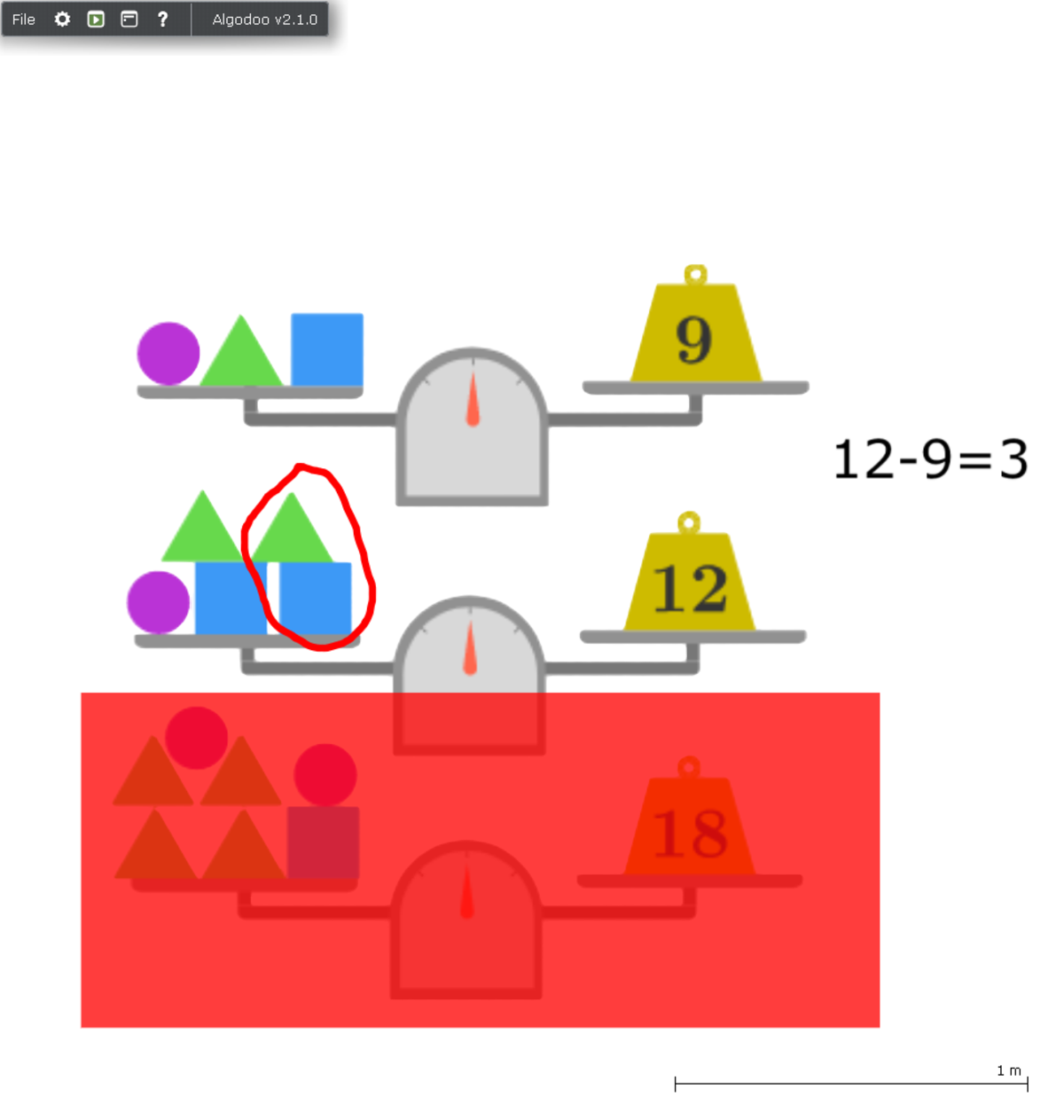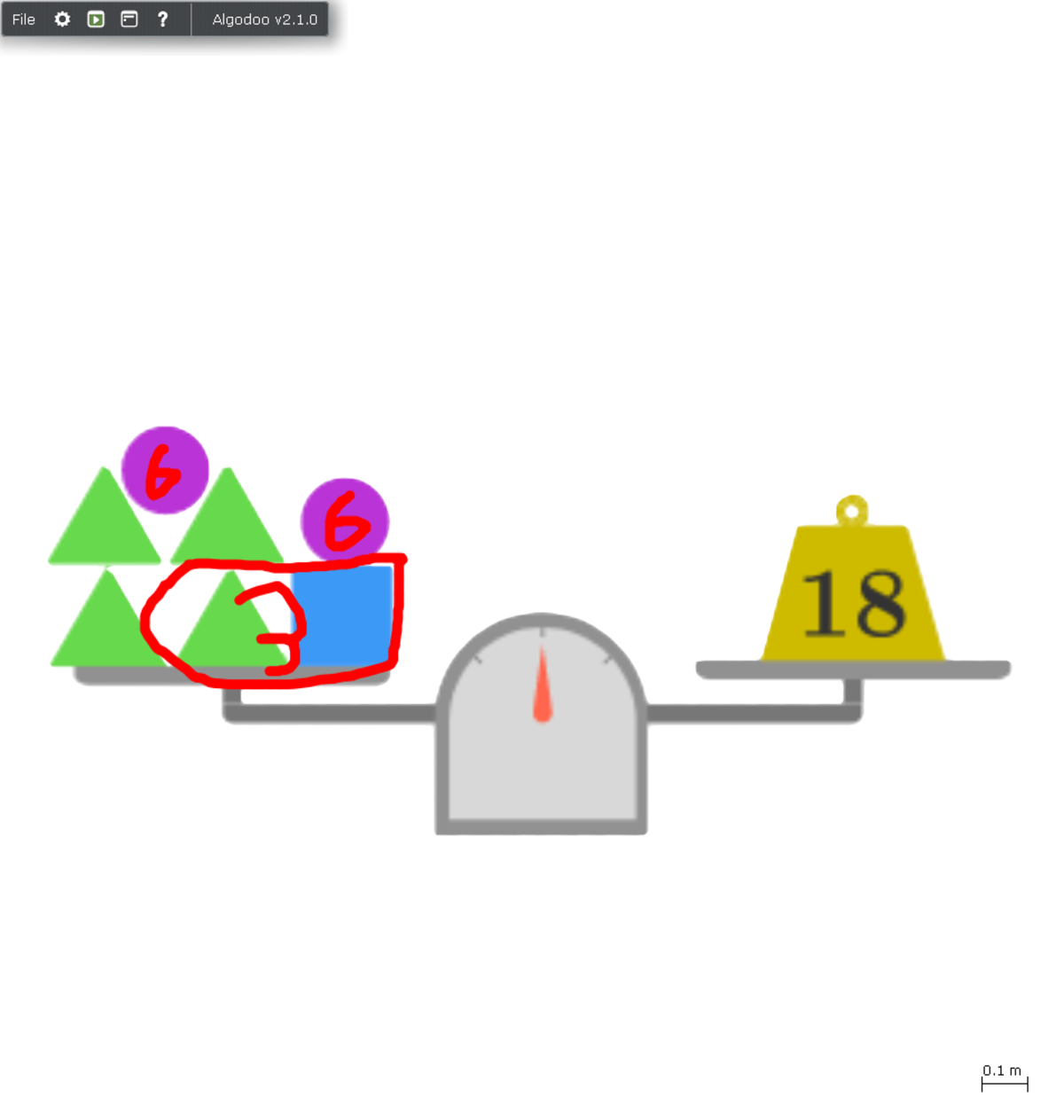62 of 100: A Weighty Issue
All the scales shown are perfectly balanced. What is the weight of one triangle?
There are lots of clever tricks to solve this one pretty quickly in your head! While you can also solve this puzzle by converting to algebraic symbols, you don't have to!
This section requires Javascript.
You are seeing this because something didn't load right. We suggest you, (a) try
refreshing the page, (b) enabling javascript if it is disabled on your browser and,
finally, (c)
loading the
non-javascript version of this page
. We're sorry about the hassle.
17 solutions
Good solution. If you reduce the diagram size it will be great.
Log in to reply
Nice advice XD
Lol! Like that one! I never think of that before. Besides, the image size can easily be fixed. :)
Thank you for the advice. Absolutely agree that the images were too large.
I updated the solution with reduced sizes. Would you please check if its good enough?
I feel that they may be a bit too small now. (width and height reduced to 1/3 their original ; should the factor have been 1/2 instead?)
Log in to reply
Added some spaces in between. I think it looks better now.
Log in to reply
@Jubayer Matin – Yes. It is better now. I think space between the diagrams are not required. If possible while writing the solution try to cover the solution in the single scree of the computer window.
I did the same process.
Yeah, this was exactly what I did!
nicely explained!
I did this. Using the figures in group is the better way to solve the problem "in the head" without passing from x+y+z=9...
Subtract three times the first scale from the sum of second and third scales. This way squares and circles vanish. You left with three triangles and 3 × triangle = 1 8 + 1 2 − 2 7 = 3 ⟹ triangle = 1
Nice one, this is what I did
That must be the clever approach.
Slightly different and very elegant, as always.
Let C be weight of circle, T be weight of triangle, and S be weight of square.
From adding the last 2 scales, we have that
3C+3S+6T=30
So,
C+S+2T=10
Since we also have C+S+T=9
Therefore, by subtracting we have
T = 1
Adding 2nd and 3rd scale makes it a multiple of the 1st scale (triple, to be specific) plus 3 triangles. Subtracting the triple of 1st scale from this sum straight away gives the weight of 3 triangles as 3, meaning thereby that the weight of one triangle is 1.
Let the respective measurements be equations ( 1 ) , ( 2 ) , and ( 3 ) .
The difference between ( 2 ) and ( 1 ) is a square and a triangle, so we have
S + T = 3
Now add ( 1 ) to ( 2 ) so that
\begin{aligned} {\color{#69047E}{CC}} \ {\color{#20A900}{TTT}} \ {\color{#3D99F6}{SSS}} & = 21 \tag{1 + 2} \\ {\color{#69047E}{CC}} \ {\color{#20A900}{TTTT}} \ {\color{#3D99F6}{S}} & = 18 \tag{3} \end{aligned}
Subtracting ( 3 ) from ( 1 + 2 ) , we have
2 S − T = 3
Finally, setting that equal to our first equation, we have
S + T S ⟹ T = 2 S − T = 2 T = 1
How did you come up with these numbers? Trial error may work at this scale, but with bigger numbers it certainly makes it hard.
I used trial and error, but I also noticed that '3' was added to the second one as well as a triangle with a circle. So a circle + triangle = 3.
My method using algebra:
The Circle = C The Triangle = T The Square = S
-
C + T + S = 9
-
C + 2T + 2S = 12
-
2C + 4T + S = 18
Using simultaneous equations we can find out what C is.
(C + 2T + 2S = 12) - (C + T + S = 9) = T + S = 3
If 'T + S = 3' then 'C = 9 - 3 = 6'
2C + 4T + S = 18
Substitute C for 6:
2(6) + 4T + S = 18
12 + 4T + S = 18
4T + S = 18 - 12
4T + S = 6
Since 'T + S = 3' then T and S must be (1 and 2) or (2 and 1)
4(1) + S = 6
S = 6 - 4
S = 2
T = 1
Nice, it really can be solved just in your head.
Note that if you subtract 9 from 12 you will find weight of SQUARE plus TRIANGLE
After you subtract 3 from 9 you will find weight of CIRCLE
After you subtract 6 and 9 from 18 you will find weight of THREE TRIANGLES
perfect, excellent.
First, let's ignore the 3rd one and think one triangle and one square as one pair.

So we know that one pair equal 3 and also we know thet one Circle equal 6.
Next, Let's look at the 3rd one.
We already know that one circle equal 6, so we can subtract 6x2=12 from 18.
There also is one pair so let's also subtract 3 from 18-12=6

So 3 divided by 3 is 1.
Hence, one triangle equal 1.
The weight of one of each combined is 9 and the weight of 2 triangles, 2 squares and 1 circle is 12. Since the second scale is 1 circle away from double the first and only has a difference of one circle, 9 doubled minus 12 would give us the value of one circle which happens to be 6. So then we take away the circle from the first scale and are left with 3, resulting in 2 possibilities, 1) TRIANGLE = 2 and SQUARE = 1 or 2) TRIANGLE = 1 and SQUARE = 2. We take away the 2 circles from the third balance resulting in the remaining net weight to be 6. From here, it is a matter of trial and error. 1) 4T * 2 + 1S * 1 = 9 which is incorrect so it must be 2) 4T * 1 + 1S * 2 = 6.
T = Triangle S = Square
Maak het verschil tussen bovenste en de middelste balans. Reultaat is 3 en is gelijk aan de som van 1 driehoek en 1 vierkant. Dus is 1driehoek 1 of 2 en een bol is 6. Pas deze waarden toe in onderste balans met 'driehoek' = 2 en de balans is niet inevenwicht. Dus moet een driehoek 1 zijn.
Double the first scales (2 circles, 2 triangles, 2 square = 9 x 2 = 18)
Compare to the second scales (1 circle, 2 triangles, 2 squares = 12)
So, one circle = 6
================
Double the second scales (2 circle, 4 triangles, 4 squares = 12 x 2 = 24)
Compare to the third scales (2 circles, 4 triangles, 1 square = 18)
So, 3 x squares = 6; so, one square = 2
================
Looking at the first scales, triangle, circle, square = 9; so triangle = 9 - 6 - 2 = 1
Let the weight of triangle and square be x and y, then
x + y = 12 – 9 = 3 and 2y – x = (9 + 12) – 18 = 3
Then, adding the two equations,
3y = 6, y = 2
Therefore, x = 3 – y = 1.
So the answer is 1.
I prefer an algebraic approach, instead of actually working with the situation we get: Say C is the weight of a circle, T , the weight of a triangle and Q , the weight of a square. We can write the equations to set the linear system, since all the scales are perfectly balanced:
C + T + Q = 9 C + 2 T + 2 Q = 1 2 2 C + 4 T + Q = 1 8
which can be solved directly to give C = 6 , T = 1 , Q = 2 .
1x + 1y + 1z = 9 1x + 2y + 2z = 12, thus the pro numerals are 6, x 1, y and 2, z
C+T+S = 9
C+T+S +T+S=12
therefore T+S=12-9 = 3
C+C +T+T+T+T+S = 18
therefore C+T+T+T = 9
because C+T+S=9 and T+S=3 then C=6 (6+3=9)
3T + C [6] = 9
So T = 1
From the first two balances, adding a triangle (T) and square (S) increases weight by three. So T + S = 3. And Circle (C) = 6 (from balance #1). Looking at the last balance, 4T+S+2C= 18. Since C=6, 4T+S=6. Since T+S = 3, we can subtract T+S from the 4T+S side and get 3T. And we can subtract 3 from 6 on the other side and keep the equality. 3T = 3. So T = 1. The weight of one Triangle is one.
Adding a triangle-square pair on the left plate adds three units of weight to the right. (fig1 & 2) From which it is possible to conclude that one such set weighs 3 units.
3 units of weight + a circle on the left plate equals 9 units on the right. (fig 1) So the circle weighs 6 units.
2 circles and a triangle-square pair would weigh: 2 × 6 + 3 = 1 5
Three more triangles + above balances 18 units of weight. (fig 3)
Therefore, three triangles weigh 3 units.
A single one weighs 1 u n i t .
Basically its algebra in words. But the key was to pair each square with a triangle, which makes it easier to think in the head.